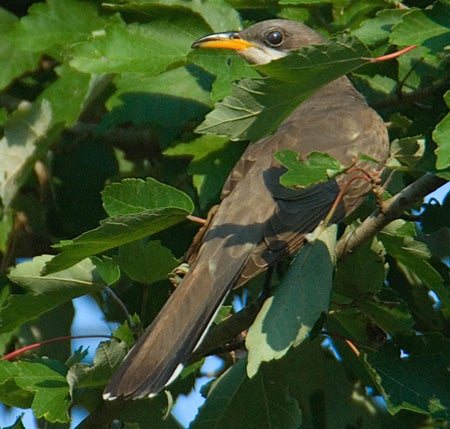SCIENTIFIC NAME:
Coccyzus americanus
OTHER NAMES:
Rain Crow
STATUS:
Breeder. Common in spring, summer, and fall in all regions. Low Conservation Concern.
DESCRIPTION:
Yellow-billed cuckoos (Coccyzus americanus) are long slender, secretive birds about the size of a mourning dove. They have pure white bellies and the upper portions of their bodies are dark brown. Their wings are somewhat reddish-brown. Their tails are very long and have large white spots on the underside. The lower portion of their beak is yellow, while the upper portion is black. One of their calls consists of a rapid series of about fifteen cuks, which gradually slows at the end. A second call is a single, deep, prolonged cooo. The yellow-billed cuckoo and the black-billed cuckoo are said to call more often just before it rains; hence, they are commonly called “rain crows”. They usually remain motionless when perched, and may go unnoticed unless they call or fly.
DISTRIBUTION:
Yellow-billed cuckoos are common, breeding, summer residents, and a common as transients throughout Alabama. Common throughout the southeastern United States, they breed from British Columbia and Quebec south to Mexico and the Virgin Islands. They are migratory, wintering from Central America south to Argentina.
HABITAT:
Yellow-billed cuckoos prefer open woodlands which include clearings and dense scrubby vegetation along water. They tend to prefer the leafier hardwoods of forest mid-stories and often are found in the shade trees of urban areas.
FEEDING HABITS:
Yellow-billed Cuckoos are great destroyers of caterpillars, readily eating the hairy types disdained by most other birds. Their stomachs often become so felted with caterpillar hairs that the bird sheds the lining and grows a new one. They also eat large numbers of beetles, bugs, locusts, grasshoppers, assorted other insects, and even small tree frogs. Occasionally, they will eat the eggs of other birds, and often eat small fruits such as blackberries.
LIFE HISTORY AND ECOLOGY:
Yellow-billed cuckoos build very flat, loosely built nests of twigs, grass, and leaves. Nests usually are less than twenty feet from the ground in the thick foliage of a hardwood tree or large shrub. Females lay two to four pale greenish-blue eggs. Chicks are altricial (hatched in a naked, blind and helpless condition), but are alert and active within minutes of hatching. Hatchlings develop very quickly and the entire time period from egg laying to fledglings leaving the nest involves only 17 days. Although yellow-billed cuckoos usually raise their own young, occasionally they will lay eggs in the nest of a different species. They are known to have laid eggs in the nest of at least 11 different bird species, most commonly those of the American robin, gray catbird, or wood thrush. Though they are classified as a species of Low Conservation Concern in Alabama, the destruction of riparian habitats throughout its range is resulting in overall population declines.
REFERENCES:
Hughes, J.M. 1999. Yellow-billed Cuckoo (Coccyzus americanus). In The Birds of North America ,No. 418 ( A. Poole and f. Gill, eds). The Birds of North America, Inc., Philadelphia, PA.
Imhof, T.A. 1976. Alabama Birds, Second edition. Univ. Alabama Press, Tuscaloosa, AL. 445 pp.
AUTHOR:
Mark S. Sasser, Wildlife Biologist, Division of Wildlife and Freshwater Fisheries






